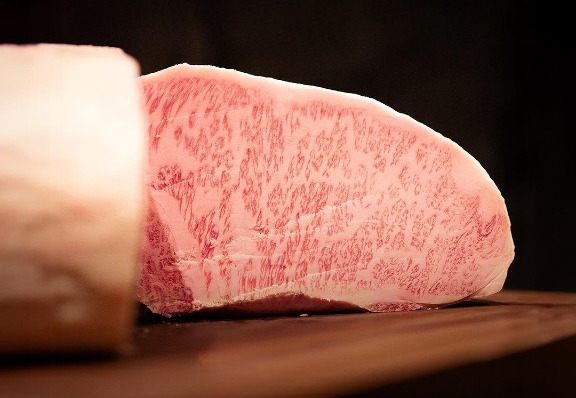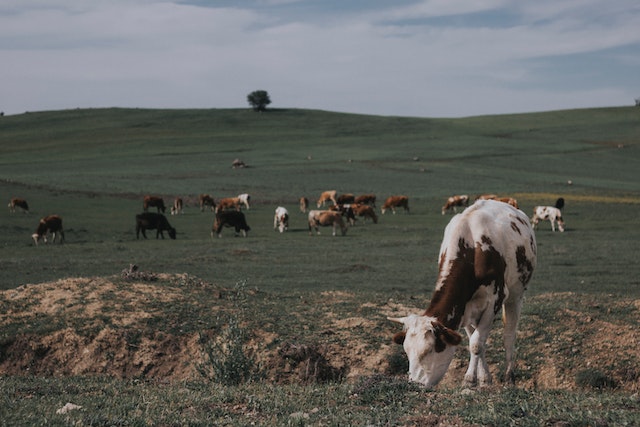The Science Of Meat, Insights From Food Scientists
 by
Leo Bisma
by
Leo Bisma  May 19, 2023
May 19, 2023
Welcome to Meatguy Steakhouse, the brainchild of Dims The Meatguy, a renowned figure in the world of meat. The science of meat plays a vital role in delivering the exquisite quality and taste you experience at our establishment.

Our mission is to serve you the finest steaks while educating you on the intricacies of what makes your meal so delicious. In this article, we'll dive deep into the fascinating world of meat, shedding light on the chemistry of flavor, the art of aging, and the techniques used to cook the perfect steak.
The Meat Science
A major component of a memorable steak experience is the flavor, and understanding the chemistry behind it will give you a deeper appreciation for the culinary artistry at Meatguy Steakhouse.
1. The Maillard Reaction: A Key Process in Developing Flavor
The Maillard reaction is a chemical process that occurs between amino acids and reducing sugars at high temperatures, resulting in the formation of brown color and characteristic flavor compounds, contributing to the development of the taste and aroma of cooked foods.
This reaction is responsible for the browning of bread crust, the crust on grilled steak, and the roasted flavors in coffee. It is a key process in developing flavor in many types of cooked foods, from baked goods to roasted meats.
Occurs when proteins and sugars in the meat are heated at temperatures between 140°C and 165°C
Creates complex and flavorful compounds responsible for the characteristic browning and enticing aroma of a perfectly cooked steak
The Maillard reaction is carefully controlled by our chefs to achieve the desired flavor intensity and crust on each cut of meat
2. The Role of Fats and Marbling in Enhancing Taste
Fats and marbling play an essential role in enhancing the taste of foods, particularly meats. Fats provide a source of flavor, and the marbling of fat in meats can add juiciness, tenderness, and flavor to the meat.
The fat content in meats can affect the cooking process, with higher fat content often requiring different cooking techniques than leaner meats. Marbling is the term used to describe the distribution of fat within the meat. The more marbled the meat, the more tender and flavorful it is likely to be.
Marbling refers to the distribution of intramuscular fat within the meat
The presence of marbling contributes to the flavor, tenderness, and juiciness of the steak
Well-marbled cuts, such as ribeye, have a higher fat content which melts during cooking, enhancing the overall taste and mouthfeel
3. Amino Acids and Their Impact on Flavor Profile
Amino acids are the building blocks of proteins, and they play a crucial role in the flavor profile of foods. Amino acids are responsible for the umami taste, which is one of the five basic tastes (sweet, sour, salty, bitter, and umami).
Umami is often described as having a savory or meaty taste and is found in foods such as soy sauce, tomatoes, and meats. Different amino acids can contribute to different flavor profiles in foods, such as the sweetness of alanine or the bitterness of phenylalanine. The combination of amino acids in a food can also influence its overall flavor profile.
Meat contains essential amino acids that contribute to its unique flavor
Glutamate, an amino acid, is responsible for the umami taste, the savory flavor that makes your mouth water
The concentration of these amino acids can vary depending on factors like the cut of meat and the animal's diet, influencing the flavor profile of each dish
The Art of Aging Meat
The aging process plays a crucial role in enhancing the flavor and tenderness of the meat. At Meatguy Steakhouse, we take great care in perfecting the art of aging our cuts to provide you with an unparalleled dining experience. In this section, we will discuss the differences between dry aging and wet aging, the role of enzymes in tenderizing meat, and the optimal aging times for various cuts of meat.
1. Dry Aging versus Wet Aging: The Pros and Cons
a. Dry Aging:
Dry aging is a technique where meat is stored in a controlled environment with specific temperatures (0-4°C) and humidity levels for an extended period.
Involves storing meat in a controlled environment with specific temperature (0-4°C) and humidity levels for an extended period
Results in the evaporation of moisture and the concentration of flavor
Creates a rich, nutty, and complex taste profile that is highly sought after by meat connoisseurs
Drawbacks include a higher cost and a greater loss of weight due to evaporation and trimming
b. Wet Aging:
On the other hand, wet aging involves sealing meat in vacuum-packed bags and storing it in a refrigerated environment (0-4°C) for a set period. This method retains moisture and allows for more consistent flavor distribution throughout the meat. Wet aging is more cost-effective and widely used in the food industry, but it may lack the distinct flavor profile associated with dry-aged meat.
Retains moisture and allows for more consistent flavor distribution
More cost-effective and widely used in the food industry
May lack the distinct flavor profile associated with dry-aged meat
2. The Role of Enzymes in Tenderizing Meat
During the aging process, enzymes naturally present in the meat break down proteins and connective tissue. This enzymatic activity results in a more tender and easier-to-chew steak.
The aging period allows these enzymes to work their magic, transforming the texture of the meat for an exceptional dining experience. Both dry and wet aging methods utilize the power of enzymes to tenderize the meat, although the specific enzyme activities and the resulting flavors and textures may vary depending on the method used.
3. Optimal Aging Times for Various Cuts of Meat
The ideal aging time varies depending on the cut of meat and the desired flavor profile. Generally, steaks can be aged between 14 and 60 days, with some cuts benefiting from even longer aging periods.
For example, a ribeye might be aged for 30 days to develop a deep, rich flavor, while a filet mignon could be aged for a shorter period, such as 21 days, to preserve its delicate taste.
At Meatguy Steakhouse, we carefully monitor the aging process to strike the perfect balance between flavor development and tenderness for each cut, ensuring that your meal is a perfect harmony of taste and texture.
Read more: The Rise of Meatless Meat: A Look at the Latest Plant-Based Alternatives
The Role of Enzymes in Tenderizing Meat
The aging process allows enzymes naturally present in the meat to work their magic, breaking down proteins and connective tissue, ultimately resulting in a more tender and easier-to-chew steak. This enzymatic activity transforms the texture of the meat, elevating it to an exceptional dining experience. In this section, we will delve into the various enzymes at work and how they contribute to the tenderness of the meat.
1. Proteolytic Enzymes: The Key Players in Meat Tenderization
Proteolytic enzymes, also known as proteases, are responsible for breaking down proteins into smaller fragments, called peptides. Calpains and cathepsins are the primary proteolytic enzymes found in muscle tissue.
These enzymes target the structural proteins, such as actin and myosin, as well as the connective tissue proteins, like collagen and elastin.
2. The Role of Calpains in Tenderizing Meat
Calpains are calcium-dependent enzymes that work optimally at temperatures between 0-4°C. They break down structural proteins, such as actin and myosin, which contribute to the overall firmness of the meat.
As calpains initiate the tenderization process during aging, they result in the initial breakdown of muscle fibers, leading to a more tender and succulent steak.
3. The Role of Cathepsins in Tenderizing Meat
Cathepsins are lysosomal enzymes that work optimally at lower pH levels, typically found in post-mortem muscle tissue. They target connective tissue proteins, such as collagen and elastin, which provide structural support and resilience to the meat.
By breaking down these proteins, cathepsins play a crucial role in softening the connective tissue, further contributing to the tenderness of aged meat.
Factors Affecting Enzyme Activity
Several factors can influence the activity of these enzymes during the aging process, including:
1. Temperature
Enzymatic activity is highly sensitive to temperature; maintaining the appropriate temperature range of 0-4°C is crucial for optimal enzyme performance.
2. pH levels
Both calpains and cathepsins have distinct pH preferences, making it essential to monitor and control the pH levels in the meat during aging.
3. Duration of aging
The aging period plays a significant role in determining the extent of enzyme activity, with longer aging times allowing for more thorough tenderization.
By understanding the role of enzymes in tenderizing meat, Meatguy Steakhouse is able to harness their power to create an exceptional dining experience for our guests.
The Perfect Temperature and Cooking Techniques
Achieving the perfect steak requires not only understanding the science of meat but also mastering the art of cooking.
In this section, we will explore the different levels of doneness, the importance of resting meat before serving, and a variety of cooking methods to help you find the perfect technique for your steak.
1. Understanding the Different Levels of Doneness
Temperature is the key to achieving your desired level of doneness:
Rare: 49-51°C - A cool, red center with a soft and tender texture
Medium-rare: 55-57°C - A warm, red center with a firmer texture and a hint of juiciness
Medium: 60-63°C - A pink center with a more pronounced firmness and less juiciness
Medium-well: 65-67°C - A slightly pink center with a firm texture and minimal juiciness
Well-done: 71-74°C - A brown, fully cooked center with a dense, firm texture
Using a meat thermometer is the most accurate way to determine the internal temperature of your steak
2. The Importance of Resting Meat Before Serving
Allowing the meat to rest after cooking is essential for achieving optimal tenderness and juiciness.
Resting enables the juices to redistribute throughout the meat, preventing them from escaping when the steak is cut
A general guideline is to rest the meat for about half the time it was cooked, although the exact resting time may vary depending on the thickness of the cut
3. Sous Vide, Grilling, and Other Cooking Methods: Which is Best for Your Steak?
Sous vide
This technique involves cooking the steak in a vacuum-sealed bag submerged in a temperature-controlled water bath, ensuring even cooking and precise temperature control
Pros: Consistent results, minimal risk of overcooking, and retains moisture
Cons: Requires additional equipment and may lack the crusty exterior produced by high-heat methods
Grilling
A popular method for cooking steaks, grilling imparts a smoky flavor and a nicely charred crust
Pros: Distinctive flavor, appealing grill marks, and great for outdoor cooking
Cons: Requires careful monitoring to avoid overcooking, and not ideal for thick cuts
Pan-searing
Cooking the steak in a hot, well-oiled skillet creates a beautiful crust while sealing in the juices
Pros: Easy to control cooking temperature, and great for achieving a caramelized crust
Cons: Can produce smoke and splatter, requiring proper ventilation and clean-up
Reverse-searing
Involves cooking the steak at a low temperature in the oven before searing it in a hot skillet
Pros: Even cooking throughout the steak, with a well-developed crust and minimal risk of overcooking
Cons: Requires more time and multiple cooking steps
At Meatguy Steakhouse, we combine our understanding of the science of meat with impeccable cooking techniques to ensure that each steak is cooked to perfection. By exploring the various levels of doneness, resting times, and cooking methods, we provide our guests with a truly exceptional dining experience.
Read more: Perfect Steak Pairings: Meats, Sides, and Sauces
Choosing the Right Cut: A Guide to Different Types of Steak
Selecting the perfect cut of steak is essential for creating a memorable dining experience at Meatguy Steakhouse. Each cut boasts its own unique characteristics, offering a range of flavors and textures to suit individual preferences. In this section, we will explore the distinct features of four popular steak cuts: Filet Mignon, Ribeye, New York Strip, and Porterhouse.
1. Filet Mignon: Tenderness at its Best
Cut from the smaller end of the tenderloin, the Filet Mignon is renowned for its unrivaled tenderness and delicate flavor
Key features:
Lean and low in fat, resulting in a mild, buttery flavor
Extremely tender, with a melt-in-your-mouth texture
Best cooking methods: Pan-searing, grilling, or sous vide to enhance the natural tenderness without overpowering its delicate flavor
2. Ribeye: Rich Flavor and Marbling
The Ribeye steak is cut from the rib section of the cow and is known for its rich, robust flavor and beautiful marbling
Key features:
Generous marbling, which enhances the flavor and juiciness of the meat
Tender, with a slightly firmer texture compared to the Filet Mignon
Best cooking methods: Grilling, pan-searing, or broiling to showcase its marbling and develop a caramelized crust
3. New York Strip: The Balance Between Tenderness and Flavor
Also known as the Strip Steak, the New York Strip is cut from the short loin and strikes a balance between tenderness and flavor
Key features:
Moderate marbling, providing a rich, beefy flavor
Firm, yet tender texture, offering a satisfying bite
Best cooking methods: Grilling, pan-searing, or broiling to highlight its beefy flavor and achieve a beautiful crust
4. Porterhouse: The King of Steaks
The Porterhouse is a large steak cut from the short loin and includes both the tenderloin (Filet Mignon) and the top loin (New York Strip)
Key features:
Offers the best of both worlds, with the tenderness of the Filet Mignon and the rich flavor of the New York Strip
Perfect for sharing, due to its generous size
Best cooking methods: Grilling or broiling to ensure even cooking and develop a mouthwatering crust on both sections
Read more: Ground Beef: Ideas for Quick, Easy, and Delicious Meals
Meat Quality and Sustainability
At Meatguy Steakhouse, we recognize the importance of quality and sustainability in the meat industry. Ensuring the highest standards in animal welfare, sourcing, and farming practices not only benefits the environment but also contributes to the exceptional taste and texture of our steaks.
1. The Role of Animal Welfare in Meat Quality
Ethical treatment of animals leads to healthier, less stressed livestock, which in turn results in higher-quality meat
Key factors in animal welfare:
Proper living conditions, including clean and spacious environments
Humane handling and transport
Access to a nutritious diet and clean water
High animal welfare standards also contribute to better marbling and tenderness in the final product
2. Grass-fed versus Grain-fed Beef: What's the Difference?
Grass-fed beef:
Cattle graze on natural grass and forage throughout their lives
Tends to be leaner, with a distinct, earthy flavor
Higher in omega-3 fatty acids and antioxidants compared to grain-fed beef
Grain-fed beef:
Cattle are often fed a diet of grains, such as corn and soy
Typically boasts a higher level of marbling, resulting in a richer flavor and juicier texture
May have a higher fat content than grass-fed beef
Both types of beef can be enjoyed at Meatguy Steakhouse, catering to individual preferences and dietary needs
3. The Impact of Sourcing and Farming Practices on the Environment
Sustainable sourcing and farming practices help reduce the environmental impact of meat production
Environmentally friendly practices to consider:
Local sourcing to reduce transportation emissions
Regenerative agriculture to improve soil health and promote biodiversity
Minimizing waste and using resources efficiently
At Meatguy Steakhouse, we are committed to supporting sustainable practices and offering our guests high-quality, responsibly sourced steaks
Health Benefits of Consuming Meat
Meat can be a valuable source of essential nutrients when incorporated into a balanced diet. In this section, we will explore the nutritional value of various cuts of meat and discuss how to enjoy meat as part of a healthy lifestyle.
1. The Nutritional Value of Different Cuts of Meat
Meat provides a range of nutrients, including:
High-quality protein for muscle growth and repair
Iron for red blood cell production and oxygen transport
Zinc for immune function and wound healing
B vitamins for energy production and brain function
Leaner cuts, such as Filet Mignon, are generally lower in fat and calories, while well-marbled cuts, like Ribeye, offer a richer flavor and higher fat content
2. The Importance of Balance and Moderation in Meat Consumption
Enjoying meat in moderation can contribute to a balanced, nutrient-rich diet
Overconsumption of meat, particularly processed and red meats, has been associated with an increased risk of certain health conditions
Aim for a diverse diet that includes a variety of protein sources, such as poultry, fish, legumes, and plant-based options
3. How to Incorporate Meat into a Healthy Diet
Choose lean cuts and opt for healthier cooking methods, such as grilling or broiling, to reduce added fats
Balance your plate with plenty of vegetables, whole grains, and healthy fats
Consider portion sizes, aiming for a palm-sized serving of meat per meal
At Meatguy Steakhouse, we are dedicated to providing our guests with delicious, high-quality steaks while promoting sustainability and healthy eating habits.
By understanding the science of meat and prioritizing ethical and environmentally friendly practices, we strive to create a memorable and satisfying dining experience for all.









